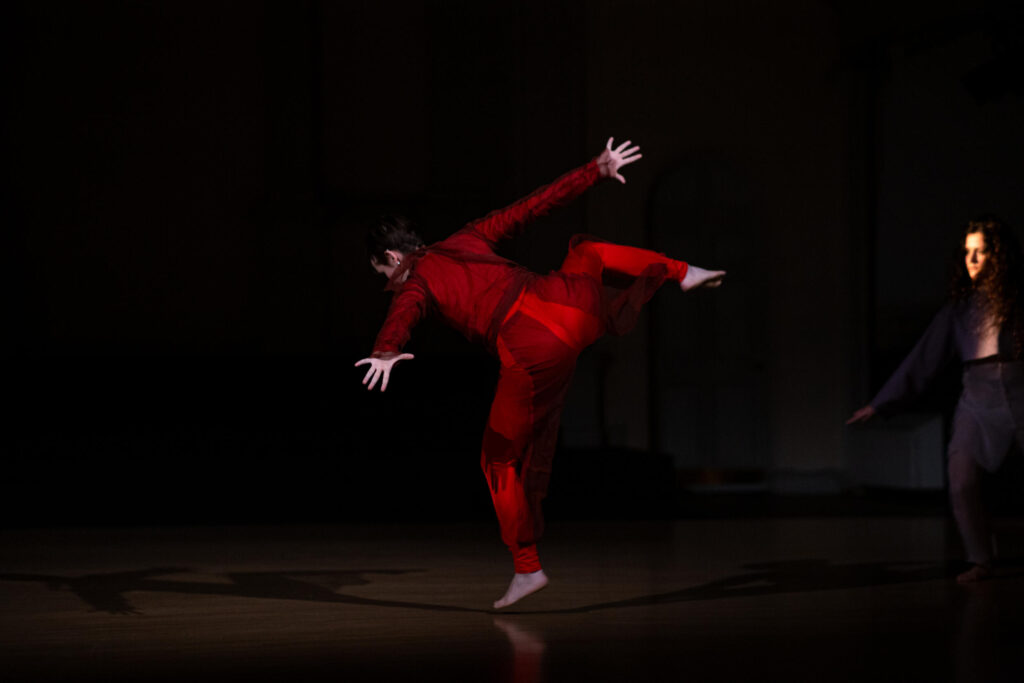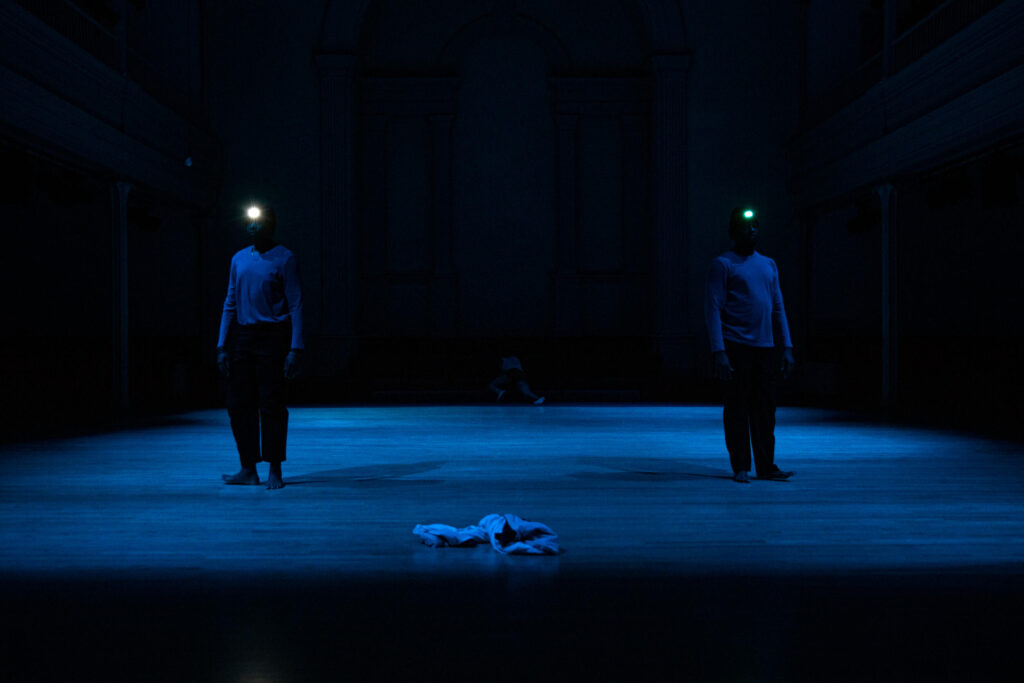Reflections: A Shared Evening with Ayano Elson + Wendell Gray II by Noa Rui-Piin Weiss
February 18, 2025

"Part Song/Immortal Life" by Ayano Elson, Danspace Project, November 2024. Pictured: Jade Manns and Amelia Heintzelman. Photo by Rachel Keane.
In a three part essay, Noa Rui-Piin Weiss reflects on a shared evening of new work by Ayano Elson and Wendell Gray II that premiered at Danspace Project November, 2024.
Listen and/or read.

A friend and lover often teases me for the time I said, “who has time for subtlety?”
Urgency and direct action rule our current moment. Or maybe my current moment, I’m a sucker for anything with a punch. But dance is not well-equipped to be direct. It’s non-verbal, untranscribable, too hazy to ever make a clear statement. The subtlety of dance is its unique strength.
Wendell and Ayano mined that hazy quality through their evening at Danspace. They showcased an underrated and beautiful element of the human body: vagueness.
Vague and its accompanying synonyms are not usually taken as compliments. But vagueness is often a key element of compelling dance. It’s what makes a performer’s body sacred. Human movement comes with an ineffable strangeness, even if you can’t quite put your finger on what it is.
Below are two close readings of dance performances that evade language through their very existence. I hope this writing takes you there if you were absent, or jostles your memory if you made it to the show.
* * * * *
Wendell stands in the church but you can imagine him under a street light in an empty parking lot past 1am, alone on the concrete. He’s in a color block windbreaker, navy pants, and white sneakers, wearing over the ear headphones with the cord tucked into his jacket. He’s grooving.
We hear a low-frequency mosquito whine, a sound that comes from inside the ear, but he’s listening to something else. The scene melds Singin’ In the Rain and a horror movie, a man alone under a naked bulb swaying, bouncing.
And then it drops away and we just hear his sneakers on the floor, his one-two-step that slides into…everything. Some internal rhythm bouncing off some other internal backbeat, the simple improvisation of one thing becomes the next becomes the next. He only pauses for a moment, throwing up his hands to sing the riff from “Ya Ya” (thank you Ms. Carter). He circles the space until his foot slides out from under him, farther, until he’s on the ground, heaving gracefully across the floor.
Jordan and Jamal re-enter and begin in symmetrical semi-unison, providing an ordered presence to cut Wendell’s gradual breakdown. Measured, waiting then moving, they mark out and carve with watchful certainty. Wendell kicks off his shoes. He floats on his stomach. The duo collects his things, picking up, circling, circling, then disappearing.
In a conversation before the show, Wendell mentioned that the duo are some form of spiritual guides. Watching the performance, it’s an interpretation of “guides” I haven’t seen before. Not the booming voice from the beyond telling you the right choice, or the invisible hand guiding your actions. They’re a parallel plane, a structured energy that floats in your space. They move unaffected by you, but they move with you.
Floodlights from stage right bathe the space as Wendell drags himself away from a pillar and melts under the lights. He’s becoming less recognizable, harder to track, his movements churning from somewhere deeper or farther away from the pedestrian place we usually live. But he stays grounded. He sticks his feet then moves. He is never skittish, always heavy, always waiting to fall to see where he lands. His arms flick, then pull, then reach.
The endless samples, mixed by Wendell and Zen, swirl interior and exterior landscapes. Mosquito whines and dial tones and that one moment of the song you just want to hear over and over bleed into each other. In both the sound and the dance, it’s impossible to tell if we’ve made it inside Wendell’s inner world, or whether we are witnessing it from afar.
The floor is washed in blue. The duo returns, slumping then rearranging then repeating. Jamal and Jordan hover in the corner then turn towards Wendell. Headlamps shine from their foreheads. Wendell lights up as their faces disappear behind the LED glow. The church is an epic aquarium full of light and sound, the music ramps up to a Prince of Egypt type of vibe.
Wendell spins and spins.
He kicks off his pants and stands downstage with arms raised, somehow younger, somehow just a boy as the pair of sentries walk patterns around him, slowly closing in.
This is not the end, it’s a beginning. These lyrics loop, teasing the audience with every repetition. We know the end is near, but we know the end is not the end.
Full orange cinema sunrise, the whole altar lights up as Wendell finally turns to address the audience. Jamal and Jordan shake, glitching in the foreground, as Wendell regards us. They float away, carried off by the current.
* * * * *
Part Song/Immortal Life is a piece of tectonic shifts and unruly bodies. It starts so slowly you can barely tell what’s happening. Ayano invites viewing that makes you notice the smallest change. If you watch closely, your experience will match the feeling of the dancers. When the body moves slowly, every weight change is an earthquake. Tilting your head is a drastic reordering of the system, a forward fold is a revolution.
Yet in all that slowness, Part Song/Immortal Life ends in a cacophony and you don’t even realize you’re there until it’s upon you. When at first the smallest change was monumental, now anything could happen. Chaos out of nothing at all.
It starts with searing slits of light. The Pillars glow.
Amelia drags her feet. Her clothing is covered in unfinished edges, her entire aura is blurry, frayed out. Except her gaze, which pierces flatly across the audience. She tugs herself away from a pillar then stumbles back towards it. It’s never quite clear where she’s going, but she remains intent. Her quality is uncanny but familiar, the stupor of knowing you need to do something but not quite knowing what it is.
Evan enters from the other corner, gesturing grandly but looking apprehensive. He is always halfway up on his toes, always with his shoulders slightly raised. He spends the entire dance looking like he’s about to do something, or like he’s trying to seem like he’s doing something (another familiar feeling).
They both move excruciatingly slowly, never betraying how difficult their tasks are. Ayano’s dancers are tuned to the radio frequency of the body. They will not illustrate it for you, but they are sensing, brushing against each other’s vibrations, tracking each person’s movements. At first, it’s difficult to tell how specific the movement is, but the choreographed score of Ayano’s piece is a testament to how the body can track specificity in a way the eye cannot.
Contrasting the dancers’ delicate listening is the sound score. Musicians Matt, Leo, Tristan, and Zosha work only in surprises, cutting the silence with erratic percussion from above. You can feel them playing with the air. It shoots through the space, compressions squeezing and reverberating into unseen corners. Drumming, clicking, jittering sounds, and every once in a while, THUMP. Like someone slammed the door of a safe. What enormous creature moves, what horrific violence is happening in the balcony? People flinch. The dancers do not. They stumble on, dragging or being dragged on invisible clothes lines around the room.
After standing facing the corner for over fifteen minutes, Jade enters. She descends, stepping backwards down the risers, heralded by shattering chords of strings that sound like horns. She undulates center stage, then leaps, freezes, and turns over and over around the space. Her hands are spread, her torso bends as her legs fly up and around. She’s diving, head on.
Evan disappears from the stage but Amelia continues to float, shifting and shifting until she jumps. Lands.
It’s over.
Disasters happen while we all stumble around doing what we’ve been doing. Will this be the jump that ends it all?